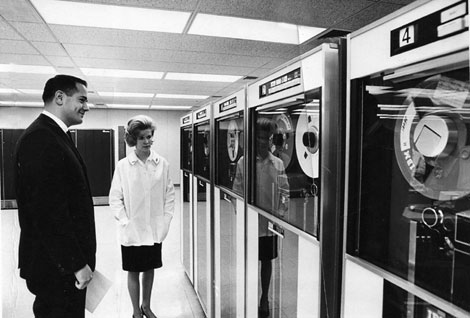Smartphones are commonplace. Almost everyone has one, including my grandchildren, who consider it a necessity. Smart phones can perform many functions of a computer; they typically have a large screen and an operating system.
Amused by my flip phone, my grandchildren were relieved to learn I had left the dark ages and finally owned a smart phone. They may feel knowledgeable of the latest technology, but have no idea their grandmother used a computer before they were born. In fact, I was working with a computer system even before their parents were born.
In 1963, I went to work for Pacific Northwest Bell in Portland, Ore. At the time, all long-distance phone calls were operator-assisted. Recordkeeping was complex, and the duration of every toll call had to be manually recorded for billing purposes. As a toll information operator, I received numerous calls each day from billing clerks across the U.S. investigating telephone fraud. My job was to locate a specific long-distance toll card from the millions of cards filed in our department, verify telephone numbers, and provide any information the operator had written on the card when the call was placed.
Technology quickly changed everything, including my job.
When Tom Watson, president of IBM, unveiled the System 360 in 1964, it was the beginning of the modern computer industry. IBM’s revenue in 1962 was $2.5 billion, and the creation of the 360 System cost twice that amount. Called the “Five Billion Dollar Gamble,†Watson literally bet the company on it. The gamble paid off, making the S/360 the most successful computer in history.
When Pacific Northwest Bell purchased IBM’s 360 mainframe computer system, it was one of the first-ever family of computers. The idea of using computers may seem normal today, but in the early 1960s it was revolutionary. Computers changed the world and my career. To my surprise, I was one of a few employees selected to operate the new computer system.
Entering Ma Bell’s computer room, I walked up a long ramp where two large automated doors swung open, exposing me to a rush of cold air. The room was built with a raised floor that accommodated a ventilation system to keep the computers cool. On the left side of the spacious room was the 360 console.
My co-worker Debbie and I wore short lab coats in the huge, sterile room filled with computers and magnetic tape drives. Along the wall near us was a viewing room with a large picture window where visitors could observe technicians and computers at work. It felt surreal to be working behind glass as people watched our every move.
The magic of computers fascinated not only other employees but the public. Debbie and I would soon provide visitors an interesting development: As we worked at the console and took turns changing the magnetic tape drives, not even our pristine lab coats could hide the fact that we were both pregnant.
In 1964, the Model 360 could perform up to 34,500 instructions per second and had 64 kilobytes (KB) of memory. Today, my smart phone with 16 gigabytes (GB) of memory equals 16 million kilobytes. My phone has more computer power than the entire room of computers I once worked with.
It is hard to comprehend, but a birthday card that sings “Happy Birthday†contains a chip with more computer power than all the Allied Forces of 1945. In fact, a smart phone today has more computer technology than all of NASA had in 1969 when it sent two astronauts to the moon. The Apollo Guidance Computer, which enabled astronauts to enter simple commands to control the spacecraft, was more basic than the electronics in my toaster.
According to Gordon Moore, one of the founders of the Intel Corporation, computer power doubles every 18 months. It makes me wonder what the future has in store, and just how smart my next phone will be.
Janet Hall Rich, who wrote this article, lives in Lakewood and is a frequent contributor to Senior Scene.
